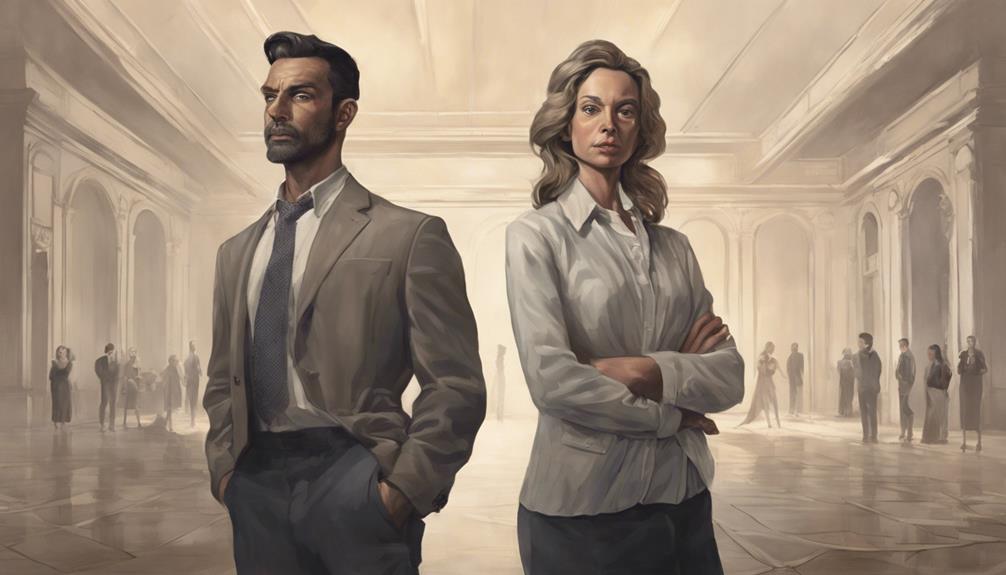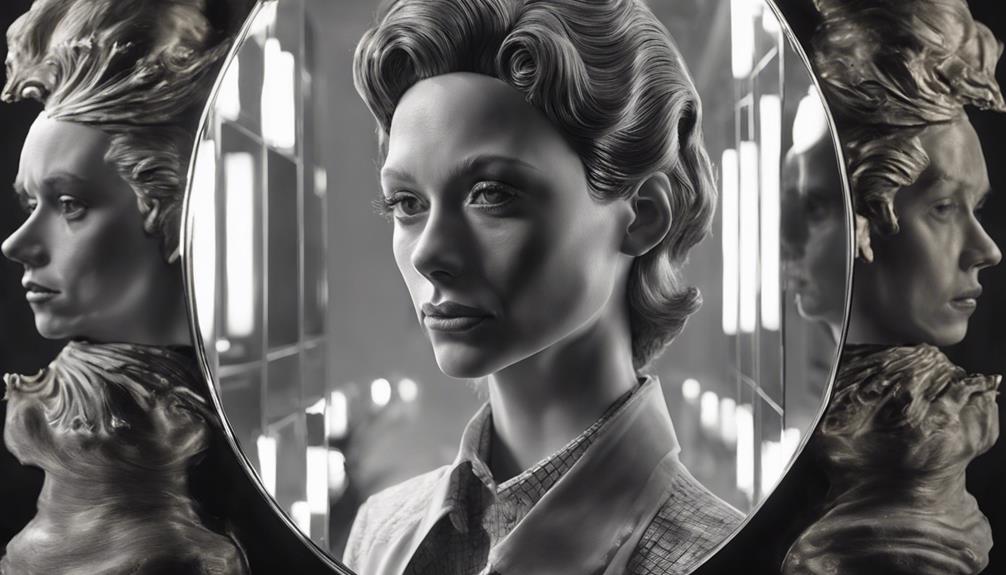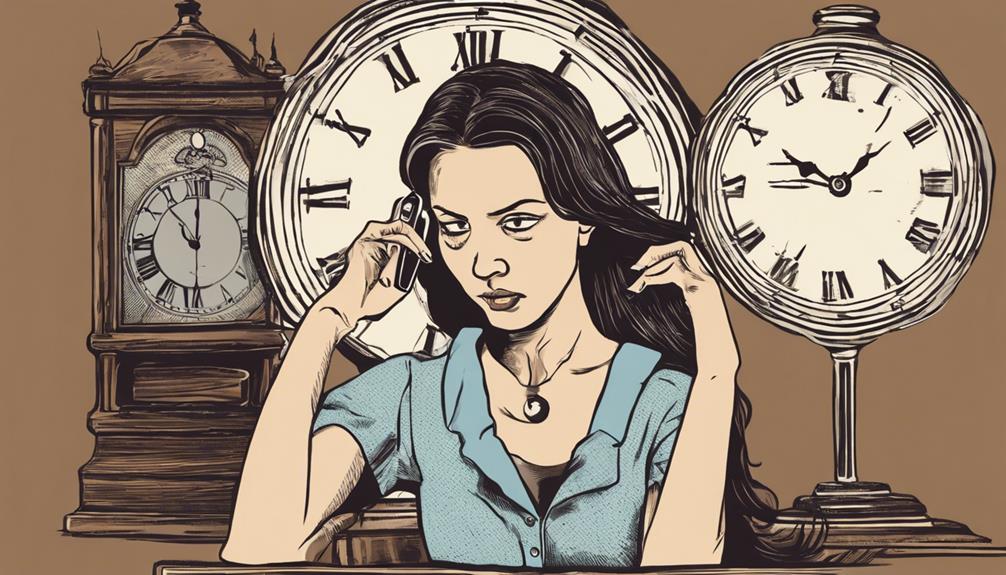As we analyze the portrayal of narcissism in iconic movie characters, we are intrigued by the intricate ways filmmakers depict this complex trait. From the magnetic charisma of Tony Stark in 'Iron Man' to the enigmatic allure of Regina George in 'Mean Girls,' narcissistic characters have a way of captivating our attention.
But what lies beneath the surface of their self-absorbed personas? Join us in unraveling the psychological depths of these characters and exploring the impact of their behavior on the cinematic landscape.
Key Takeaways
- Narcissistic characters in movies span various genres and are portrayed with depth and complexity.
- Male narcissistic characters dominate film portrayals, overshadowing depictions of female narcissists.
- Audience perception of narcissism is influenced by media, often blurring the lines between narcissism and psychopathy.
- Challenges in accurately representing narcissistic personalities in movies call for more nuanced and realistic portrayals.
Key Narcissistic Characters in Movies
In examining the landscape of iconic movie characters, a plethora of key narcissistic figures emerge, each leaving a distinctive mark on cinematic history. Characters like Miranda Priestly from 'The Devil Wears Prada' and Patrick Bateman from 'American Psycho' stand out for their compelling portrayals of narcissism.
Miranda Priestly, with her icy demeanor and demanding attitude, symbolizes the epitome of narcissistic behavior in the fashion world. Patrick Bateman, on the other hand, embodies a darker side of narcissism with his violent and obsessive tendencies.
These characters captivate audiences by showcasing the complexities of narcissistic personalities, drawing us into their twisted worlds and challenging our perceptions of self-absorption in the realm of cinema.
Gender Disparities in Narcissistic Portrayals

Examining the portrayal of narcissistic characters in films, we now shift our focus to explore the gender disparities evident in these cinematic representations.
In cinema, male characters are often depicted as possessing narcissistic traits more frequently than their female counterparts. This trend reflects societal norms and expectations surrounding gender roles and behavior. Men are commonly shown as assertive, dominant, and self-centered, aligning with traditional views of masculinity.
On the other hand, female characters with narcissistic tendencies are less commonplace, possibly due to stereotypes and societal perceptions of women as nurturing and empathetic. These gender imbalances in narcissistic portrayals in film highlight broader issues of representation and the need for more diverse and nuanced characterizations across genders.
Female Narcissistic Characters in Films
Exploring the portrayal of female narcissistic characters in films reveals intriguing insights into gender dynamics and character representations in cinema. In movies, female narcissists are often depicted as complex individuals with a range of manipulative behaviors and self-centered traits. These characters challenge traditional gender norms and provide a platform for exploring the intricacies of narcissism through a feminine lens. By delving into the psyche of these female characters, audiences can gain a deeper understanding of the nuances surrounding narcissistic traits and their impact on storytelling. Through nuanced performances and compelling narratives, these films shed light on the complexities of narcissism and its intersection with gender roles.
| Female Narcissistic Characters | Films |
|---|---|
| Mother Gothel | Tangled |
| Angelina Jolie's character | Girl Interrupted |
Audience Perceptions of Narcissistic Characters

Transitioning from the exploration of female narcissistic characters in films, our focus now shifts towards the audience perceptions of narcissistic characters and their impact on viewers' understanding of complex personalities in cinema.
Viewers often empathize with narcissistic characters, drawn to their confidence and charisma.
Some audience members may misinterpret narcissistic behaviors as admirable traits, blurring the lines between healthy confidence and toxic self-absorption.
Audience reactions to narcissistic characters can vary, with some finding them entertaining while others see them as cautionary tales.
The portrayal of narcissistic characters can spark introspection in viewers, prompting reflections on their own relationships and behaviors.
Challenges in Depicting Narcissism on Screen
Depicting narcissism on screen presents filmmakers with the challenge of accurately portraying complex behavioral traits while avoiding oversimplification. It requires a delicate balance to showcase the grandiosity, lack of empathy, and manipulative tendencies typical of narcissistic characters without veering into caricature.
The nuances of narcissistic behavior, such as superficial charm masking underlying insecurities, demand a nuanced approach to ensure a multifaceted portrayal. Moreover, distinguishing narcissism from related personality disorders adds another layer of complexity.
Striving for authenticity in depicting narcissism is essential to provide viewers with a genuine understanding of these intricate characters. By delving deep into the psyche of narcissistic individuals, filmmakers can offer audiences a more insightful and thought-provoking exploration of this captivating yet challenging personality trait.
Impact of Media on Narcissistic Traits Awareness

The media plays a crucial role in shaping awareness and understanding of narcissistic traits in society.
- Celebrity Influence: Celebrities' behaviors and actions often mirror narcissistic traits, influencing societal perceptions.
- Sensationalism: Media's focus on sensationalized stories of narcissistic individuals can distort public understanding of narcissism.
- Educational Content: Documentaries and articles that delve into narcissistic behaviors help educate the public on recognizing such traits.
- Social Media Impact: Platforms like Instagram and TikTok can perpetuate narcissistic tendencies by promoting self-centered behaviors and validation-seeking.
Identifying Narcissistic Behaviors in Films

Analyzing films for narcissistic behaviors presents a unique challenge in the realm of character portrayal and audience interpretation. It requires a keen eye to identify subtle cues that hint at narcissistic tendencies within a character's actions, dialogues, and relationships.
The portrayal of narcissism in films often intertwines with other personality traits, making it a complex task to pinpoint solely narcissistic behaviors. Additionally, filmmakers may opt for exaggerated or stereotypical representations of narcissism, which can sometimes distort the true nature of the disorder.
Therefore, viewers must approach such portrayals with a critical mindset, separating exaggerated traits from authentic depictions of narcissistic behavior to gain a more nuanced understanding of these complex characters.
The Need for Nuanced Narcissistic Representations

When exploring the portrayal of narcissism in films, it becomes evident that a more nuanced representation is crucial for a deeper understanding of complex characters. Our analysis delves into the intricacies of narcissistic traits that go beyond surface-level depictions, shedding light on the following key aspects:
- Psychological Depth: Unveiling the underlying insecurities and vulnerabilities that often drive narcissistic behaviors.
- Impact on Relationships: Exploring the subtle dynamics and power play involved in narcissistic interactions with others.
- Evolution of Character: Showing the development or regression of narcissistic traits over the course of a narrative.
- Intersectionality: Considering how factors like gender, race, or socio-economic status influence the portrayal of narcissism in diverse characters.
Overcoming Stereotypical Portrayals in Movies

Moving beyond surface-level depictions, a more nuanced approach to portraying narcissistic characters in movies is imperative to enhance the audience's understanding of complex personalities. Stereotypical portrayals often reduce narcissistic characters to one-dimensional caricatures, overlooking the intricacies of their behavior.
By delving deeper into the motivations, vulnerabilities, and internal conflicts of these characters, filmmakers can challenge common stereotypes and offer a more authentic representation of narcissism. This shift allows viewers to engage with the characters on a deeper level, fostering empathy and insight into the complexities of narcissistic traits.
Overcoming stereotypical portrayals in movies not only enriches the storytelling experience but also contributes to a more profound exploration of human behavior and psychology in cinema.
Frequently Asked Questions
How Do Actors Prepare for Portraying Narcissistic Characters on Screen?
When we portray narcissistic characters, we immerse ourselves in their mindset by studying their traits, motivations, and behaviors. It involves deep psychological exploration, understanding the character's ego, vulnerabilities, and manipulative tendencies to deliver an authentic performance.
Are There Any Real-Life Cases of Individuals Being Influenced by Narcissistic Characters in Movies?
We've observed subtle parallels between movie characters and real-life behaviors, where individuals may unknowingly adopt traits of narcissistic characters they admire, blurring lines between reel and reality, showcasing the power of cinema.
What Are Some Common Misconceptions About Narcissistic Behavior That Movies Often Perpetuate?
We often find movies perpetuate the misconception that narcissistic behavior is solely grandiose and flashy, neglecting the more subtle manipulative tactics narcissists employ. This oversimplification can lead to a shallow understanding of this complex personality trait.
How Do Directors and Writers Ensure the Accuracy of Narcissistic Portrayals in Films?
To ensure the accuracy of narcissistic portrayals in films, directors and writers collaborate closely, conducting thorough research, consulting experts, and studying real-life cases. They prioritize authenticity, complexity, and depth to create compelling and realistic characters.
Are There Any Specific Techniques or Methods Used in Cinematography to Convey Narcissistic Traits in Characters Visually?
We find that filmmakers often use visual cues like tight close-ups, mirrors, and grandiose settings to convey narcissistic traits in characters. These techniques immerse viewers and provide a deeper understanding of the character's psyche.
Conclusion
In conclusion, as we unravel the complexities of narcissistic characters in film, it becomes evident that their portrayal offers a unique insight into the human condition.
Through their captivating yet often misunderstood traits, these characters challenge our perceptions and spark conversations about self-absorption and manipulation.
By exploring the nuances of narcissism on screen, we gain a deeper understanding of the intricacies of human nature.
So, grab your popcorn, sit back, and enjoy the timeless allure of these iconic movie characters.
Augustus is the visionary leader and Editor-in-Chief of Personality-Test.net. With an unwavering commitment to quality and authenticity, he oversees all content, ensuring it enlightens and empowers our audience. Augustus believes deeply in the transformative power of self-awareness and is dedicated to making Personality-Test.net a beacon for those on a journey to understand themselves better.










